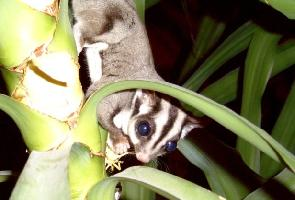
Greutăți și măsuri
| Lungime | de la 25 la 27 cm |
|---|---|
| Greutate | de la 250 la 400 g |
Descrierea animalului
The Striped Possum (Dactylopsila trivirgata) is a distinctive and fascinating marsupial native to the forests of New Guinea, as well as the Cape York Peninsula in Australia. This nocturnal creature is a part of the family Petauridae, which also includes gliders and other possums. Its unique appearance and specialized feeding habits make it a subject of interest among wildlife enthusiasts and researchers alike.One of the most striking features of the Striped Possum is its coat pattern. The animal's fur is predominantly black, with three conspicuous white stripes running longitudinally down its back. This coloration not only grants it its common name but also provides camouflage amidst the branches and foliage of its arboreal habitat. The underparts are usually a lighter color, ranging from grey to white. Adding to its distinctive look are its long, bushy tail and large, pointed ears, which enhance its sensory capabilities in the dense forest environment.
The Striped Possum is relatively small, with its body length ranging from 25 to 35 centimeters (10 to 14 inches), and the tail adding another 35 to 40 centimeters (14 to 16 inches) to its length. Despite its modest size, it has a robust and elongated body, well-adapted for its arboreal lifestyle. The possum's limbs are strong, with sharp claws that aid in climbing and gripping tree branches. One of its most remarkable adaptations is the fourth finger on its forelimbs, which is elongated and functions almost like a separate tool, primarily used for extracting insects from crevices in wood.
Dietarily, the Striped Possum is specialized and somewhat unique among marsupials. It primarily feeds on wood-boring insects, such as termites and beetle larvae, using its elongated fourth finger to dig them out of tree trunks and branches. This feeding habit has earned it the nickname "the striped carpenter." Additionally, it may consume a variety of fruits, nectar, and occasionally small vertebrates, making its diet somewhat opportunistic based on the availability of food sources.
Behaviorally, the Striped Possum is solitary and nocturnal. It spends the daylight hours in nests made within tree hollows or dense foliage, emerging at night to forage. Its movements through the canopy are agile and precise, demonstrating the animal's adaptation to a life spent predominantly off the ground. Communication among Striped Possums is not well-documented, but like many solitary animals, it is believed to involve scent marking and possibly vocalizations to establish territories and avoid conflicts.
Reproduction in Striped Possums follows the typical marsupial pattern, with females giving birth to very undeveloped young that then continue to grow and develop inside the mother's pouch. The specifics of their breeding cycle, including gestation period and pouch time, are not well-documented but are believed to align with those of similar marsupial species.
The Striped Possum plays a significant role in its ecosystem, primarily through its diet. By consuming wood-boring insects, it helps control the population of these potential pests and possibly contributes to the health of forest trees. However, like many forest-dwelling species, it faces threats from habitat loss due to deforestation and land conversion for agriculture. While currently not listed as endangered, the conservation of its habitat is crucial for the continued survival of this unique marsupial.
In conclusion, the Striped Possum is a remarkable example of adaptation and specialization within the marsupial family. Its striking appearance, unique dietary habits, and arboreal lifestyle make it a fascinating subject for study and an important part of the biodiversity in its native habitats. Conservation efforts are essential to ensure that this distinctive creature continues to thrive in the forests of New Guinea and Australia.
Animale similare
Fotografii noi cu animale
Top 10 animale
- Dolphin gull (Leucophaeus scoresbii)
- Diana monkey (Cercopithecus diana)
- Moustached guenon (Cercopithecus cephus)
- Galápagos tortoise (Geochelone nigra complex)
- Russian tortoise (Testudo horsfieldii)
- Stone loach (Barbatula barbatula)
- Japanese macaque (Macaca fuscata)
- Greek tortoise (Testudo graeca)
- Common flying dragon (Draco volans)
- Vendace (Coregonus albula)
